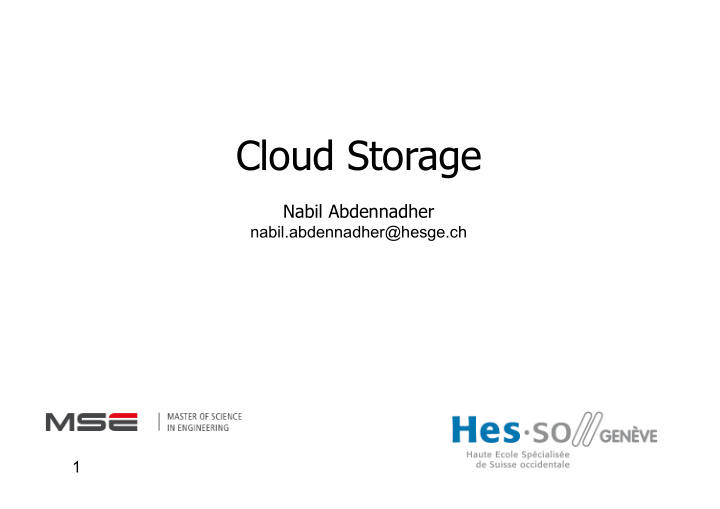



Cloud Storage Nabil Abdennadher nabil.abdennadher@hesge.ch • 1
Cloud storage Objective • Provide logical storage pools that • abstract a more complex distributed infrastructure made of commodity hardware Separate storage service from • storage deployment As a Service • A logical storage pool accessible • over the network As a System • A distributed architecture spanning • over multiple servers • 2
Cloud storage interfaces • Block storage • Object storage • • 3
Block storage Block storage devices provide fixed-sized • raw storage capacity. Each storage volume can be treated as an • independent disk drive and controlled by an external server operating system. Block device can be mounted by the guest • operating system as if it were a physical disk. Block storage is the most commonly used • storage type for most applications. Block storage can be either locally or • network attached. Not usable by humans without a filesystem • • 4
Block storage access • 5
File storage (filesystems) • 6
Block storage use-cases Databases: DBs require consistent I/O performance and low- • latency connectivity. RAID Volumes: combine multiple disks organized through • stripping or mirroring. Running mission-critical applications • • 7
Cloud Block storage AWS Elastic Block Storage (EBS) :attach to your ec2 • instances. You can create EBS General Purpose (SSD) and Provisioned IOPS (SSD) volumes up to 16 TB in size, and slower, legacy magnetic volumes. Rackspace Cloud Block Storage • Azure Premium Storage • Google Persistent Disks : Two types of block storage are • available: Standard Persistent Disk and Solid-State Persistent Disks. Cinder : Block Storage service for OpenStack • • 8
Object storage • 9
Object storage access : r/w • 10
Object storage Data kept on object storage devices are accessed directly • through APIs or http/https. Data : photos, videos, and log files. • The object store guarantees that the data will not be lost. • Object storage data can be replicated across different data • centers and offer simple web services interfaces for access. Anyone who’s stored a picture on Facebook has used object • storage. • 11
Object Data contains three things … The data itself: the data can be anything you want to store. • Metadata: the metadata is defined by the user; it contains • contextual information: what data should be used for, its confidentiality, etc. A globally unique identifier: the identifier is an address given • to the object in order for the object to be found over a distributed system. This way, it’s possible to find the data without having to know the physical location of the data. • 12
Object storage use-cases Storage of unstructured data like music, image, and video • files. Storage for backup files database dumps, and log files. • Application developers who deal with large amounts of user- • generated media, using object storage to store unlimited media files. As data stores scale to hundreds of terabytes and then into • the petabyte range and beyond, object storage becomes even more attractive. • 13
Object storage use-cases • 14
Object storage use-cases Amazon S3 : Amazon S3 stores data as objects within • resources called “buckets.” Rackspace Cloud Files • Azure Blob Storage • Google cloud storage • Swift : Object Storage service for OpenStack • • 15
Recommend
More recommend